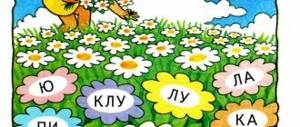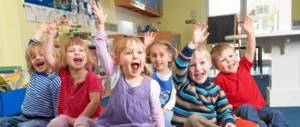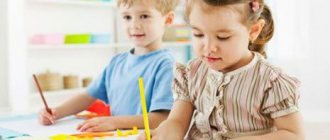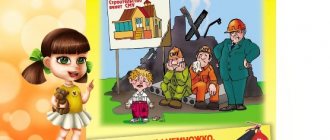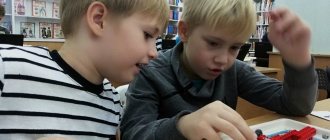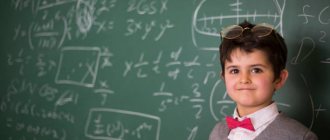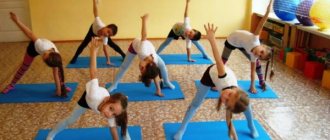Program of correctional and developmental activities for children with disabilities
Author's program
Correctional and developmental classes
for children with disabilities
(with mental retardation)
Explanatory note
Mental retardation is a slowdown in the pace of a child’s entire mental development in the presence of significant potential. This is a temporary developmental disorder that can be corrected the sooner the more favorable the child’s development conditions are. Delayed mental development in children is more often detected upon entering school and is expressed in insufficient general knowledge, limited ideas, immaturity of thinking, low intellectual focus, predominance of gaming interests, and rapid satiety in intellectual activity.
Behavior is a system of interrelated reactions carried out by living organisms to adapt to the environment. In human psychology, behavior is considered as an external manifestation of his activity, that is, a dynamic system of interaction between the subject and the world.
Only through a long process of socialization does a child master socially acceptable forms of behavior. This is one of the most important goals of the educational process, on the one hand, and at the same time a condition for the successful activity and socialization of the child, on the other.
Education of socially approved behavior is one of the most important and difficult goals of correctional pedagogy. Deviations in an individual’s behavior not only result in losses for society, but also negatively affect the development of the individual himself.
The implementation of tasks for the education of normative behavior in children with mental retardation is complicated due to the deficient, weakened development of mainly the psychophysiological basis of behavioral mechanisms. We are talking about the so-called affective-volitional sphere of the personality, which ensures the voluntary self-regulation of the personality in its interaction with the environment.
In children with mental retardation, disorders in the affective and behavioral spheres are much more frequent than in children with the norm. It is for these reasons that behavioral correction is very important when working with students with mental retardation. Correctional work in this area should be aimed at developing socially adequate behavior in students.
The period of primary school age is the most favorable for the formation of the necessary mental functions and socially significant personality traits. It is at this time that the foundations of the child’s future educational activities are laid, and his cognitive abilities are actively developing.
The goal of the program: to develop skills of interpersonal interaction with peers, to reveal the creative, moral, and intellectual potential of children with mental retardation.
Main goals:
- developing a sense of empathy, a better understanding of oneself and others, learning the ability to be at peace with oneself;
- creating opportunities for self-expression, developing in children the skills and abilities of practical mastery of expressive movements - means of communication (facial expressions, gestures, pantomime);
- developing positive character traits in children that contribute to better mutual understanding when communicating;
- increasing the level of self-control in relation to one’s emotional state during communication, developing tolerance for the interlocutor’s opinion.
The program is intended for 2nd grade students.
Since it is difficult to determine a specific topic for classes, since the program is based on an integrated approach, the lesson is held not so much on a specific topic, but rather on a specific plot. During classes, students become familiar with the rules and “secrets” of communication. The proposed games and gaming tasks are aimed at developing certain mental functions, as well as certain personal qualities (moral-volitional, self-control, self-organization, communication skills). Within one lesson, games and tasks are selected so that difficult ones alternate with easy ones.
Classes take no more than 35 minutes, which fully corresponds to the age, psychological and physical capabilities of a primary school student with mental retardation, and are conducted with a group of students once a week. It is advisable that the subgroup consist of no more than six children.
Depending on the condition of the children and the specific conditions of the classes, the order of games and exercises can be changed.
The main teaching methods are: exercises (of a creative and imitative-performing nature), games with rules: role-playing, verbal, movement, didactic, educational games, conversations, modeling and analysis of given situations, an adult’s story and children’s stories, collage application and etc.
Perspective thematic plan
| № | Title of activity/goal | Number of hours |
| 1 | Lesson No. 1. Goal: formation of a new team, familiarization with the concept of “mood” and its influence on a person’s mental health; enrichment of the emotional sphere with positive experiences | 1 |
| 2 | Lesson No. 2. Goal: to develop attention to the people around you. | 1 |
| 3 | Lesson No. 3. Goal: developing the ability to listen to your interlocutor, training observation skills. | 1 |
| 4 | Lesson No. 4. Goal: develop imagination. | 1 |
| 5 | Lesson No. 5. Goal: developing respect and polite attitude towards people. | 1 |
| 6 | Lesson No. 6. Goal: development of empathy, attention, mutual respect. | 1 |
| 7 | Lesson No. 7. Goal: develop the ability to express your mood and feel the state of another. | 1 |
| 8 | Lesson No. 8. Goal: establishing the causes of psychological discomfort, developing the ability to take into account the position of another. | 1 |
| 9 | Lesson No. 9. Goal: developing the ability to address and ask questions. | 1 |
| 10 | Lesson No. 10. Purpose: to summarize the basic knowledge and skills acquired during classes. | 1 |
Lesson structure:
- Welcome Ritual
- Warm-up
- Main content: conversation, games, exercises, etc.
- Reflection: liked it or not. Why?
Contents of classes
Lesson No. 1
Goal: formation of a new team, familiarization with the concept of “mood” and its influence on a person’s mental health; enrichment of the emotional sphere with positive experiences
| Welcome Ritual | |
| Exercise “Let’s get acquainted” | The exercise is done in a circle. Everyone calls themselves by name. Then one of the participants stands in the center of the circle and throws the ball to everyone in turn, calling them by name. The exercise can be repeated several times and in several classes. The educational psychologist voices the first “secret of communication”: If you call a person by name, then he will call you by name. (the rule is posted on the demonstration stand). |
| Game "What I love most..." | Students sit in a circle. The educational psychologist begins the game with the words I love most... And adds to this phrase what he really loves (this could be some kind of action, or a dish, or a favorite object, or a person). The next player repeats the same phrase “What I love most is...” and adds something of his own to it, etc. The game continues until all players say what they like. |
| Game "Show the mood" | Participants sit at a table. The educational psychologist lays out cards with pictures of people’s faces on the table, invites them to look at them and discuss what emotion each face expresses. Then participants take one card and repeat the emotion depicted on it. During the game, the educational psychologist draws children's attention to positive and negative emotions, explains the influence of emotions on a person, in which cases people are upset, happy, angry, and emphasizes that it is more pleasant to be friends with cheerful and kind people than with angry and dissatisfied ones. The psychologist introduces the concept of “Mood” - this is a person’s state of mind. Mood depends on the emotions a person experiences. |
| Exercise “Compliments” | Children stand in a circle. Psychologist giving the ball to one of the children, compliments him. The child should say “thank you” and pass the ball to the neighbor, while saying kind words to him. The one who accepted the ball says “thank you” and passes it to the next child. Children, saying compliments and words of gratitude, pass the ball first to one side, then to the other. |
| Reflection. Ritual of farewell. Homework “Draw a gift” | The lesson ends with a farewell ritual (gifts, smiles, kind words). Children are invited to draw what they would like to give to someone in the group. |
Lesson No. 2
Goal: develop attention to people around you.
| Welcome Ritual | |
| Exercise “Whisper my name” | Children sit in a circle. Each person whispers his name to the neighbor who sits on the left. The neighbor on the left says, “Hello (neighbor's name),” then whispers his name to the neighbor on the left. And so on until everyone says their name. |
| Checking homework | It turns out what the child wanted to give and to whom, why specifically to this child. The material from the previous lesson is repeated. The second “secret of communication” - Be attentive to those around you, and people will respect you! (the rule is posted on the demonstration stand). |
| Exercise “I am friends with you” | The educational psychologist and the participants sit on chairs in a circle. The educational psychologist extends his hand to his neighbor from either side with the words: “I am friends with you.” The one to whom the hand was extended takes hold of it and extends his free hand to the other participant, pronouncing the same words. So gradually, along the chain, everyone joins hands. Educational psychologist draws children's attention to how friendly and united they are. |
| Exercise "Artist". | One of the participants is an “artist”. He decided to paint a portrait of a friend. He looks carefully, chooses a “nature”, then turns his back to the guys and begins to “draw”, that is, gives a verbal portrait. The rest must determine who the artist was describing. |
| Game "Shadow" | A soundtrack of calm music plays. Two children are selected from a group of children. The rest are “spectators”. One child is a “traveler”, the other is his “shadow”. The “traveler” walks across the field, and behind him, two or three steps behind, comes the second child, his “shadow.” The latter tries to exactly copy the movements of the “traveler”. It is advisable to stimulate the “traveler” to perform various movements: “pick a flower”, “sit down”, “jump on one leg”, “stop and look from under the hand”, etc. |
| Conversation. "On the way to school" | The teacher-psychologist asks them to remember what the children saw on the way to school, what unusual things they noticed today. |
| Reflection. Ritual of farewell. Homework. | The lesson ends with a farewell ritual (gifts, smiles, kind words). Drawing on the theme “What I saw on the way to school.” |
Lesson No. 3
Goal: developing the ability to listen to an interlocutor, training observation skills.
| Welcome Ritual | |
| Game “Let's call each other affectionately” | Participants sit on chairs in a circle. The teacher-psychologist asks them to remember how they are affectionately called by mothers, grandmothers, etc. Then they are asked to throw a ball to each other, while the participant to whom the ball hits says his affectionate name. After everyone has said their names, the ball is thrown in the opposite direction. In this case, you need to remember and say the affectionate name of the person to whom you are throwing the ball. |
| Checking homework | Review and discussion of home drawings. |
| Exercise “Getting ready for the road” | The psychologist asks the children to imagine that they are going on a difficult journey and packing a suitcase. You can, among other things, put two important qualities in your suitcase. Children must name these two important qualities and explain why they chose them. |
| Exercise Broken phone." | In a group of children, one driver is selected at their request. Then the whole group stands with their backs to him, and no one peeps. The child approaches one of the children and, secretly from the others, shows him some pose (he invents it himself). Then the driver turns away and steps aside. The child who was shown the pose chooses another participant and shows him the pose that he saw, etc. When all the children are shown the poses, they stand in a circle facing each other. The driver shows his position, and the child who finished the game last also shows his position. The first and last pose are compared. |
| Exercise “Listening to Silence.” | All children are invited to close their eyes and listen to the silence: in the corridor, in the room, on the street. Then find out who heard what. The third “secret” of communication is - Learn to listen carefully to another, and you will learn a lot of new things (the rule is posted on the demonstration stand). |
| Exercise "Writer". | Everyone is invited to take one picture from the box (story pictures), determine their sequence and compose a story. Each child must come up with one or two sentences using their picture. |
| Joint application-collage | Magazine clippings are laid out on the table. Participants are invited to choose a theme for the application (our flowerbed, we are on an excursion, favorite animals, we are sailing on a ship, travel, etc.) and favorite clippings. IN Depending on the topic, each participant glues their pictures. The teacher-psychologist ensures that each child participates in the creation of the plot. At the end of the work, the educational psychologist draws the children’s attention to the fact that they made such an interesting collage because they listened to each other attentively. |
| Exercise “Bragging on your neighbor” | Everyone really likes it when people say nice things about him. Today we will play braggarts. Let's just brag not about ourselves, but about our neighbor. After all, it is so pleasant and honorable to have the best neighbor. Look at the person sitting to your right. Think about what it is like, what is good about it? What can he do, what good deeds has he done? What can you like about him? Remember what he said About Me |
| Ritual of farewell. Homework. | The lesson ends with a farewell ritual (gifts, smiles, kind words). Drawing on the theme “My Dream”. |
Lesson No. 4
Goal: develop imagination.
| Welcome Ritual | |
| Exercise “Say hello in a circle” | Participants sit on chairs in a circle. Light background music is playing. Participants are invited to convey greetings around the circle, touching the palm of the neighbor on the right. The exercise begins with a teacher-psychologist. The neighbor on the right accepts the greeting and touches his neighbor’s palm in exactly the same way, conveying hello to him, and so on, until hello returns again to the host. The exercise can be repeated until all participants are presenters. |
| Checking homework | They discuss what children dream about, whether they have common dreams, and what needs to be done to make the dream come true. |
| Game "Magic Chest" | The educational psychologist takes a picture out of the chest and with his hands and actions shows what is depicted on it or what is being done with this object. For example, he smells a flower, eats, digs with a shovel, etc. Whoever guessed first takes the next picture from the chest and shows the others what is shown in the picture. The game is played until each participant performs some action. |
| Exercise "Meeting". | The two friends haven't seen each other for a long time. They dream of meeting. The task is given to show how two friends will meet after a long separation. |
| Exercise “Gift”. | You need to choose one person from the group to whom you want to give a gift. According to the terms of the game, the gift must be imaginary, that is, it can only be described using facial expressions and gestures (each person in the group must receive a gift, the giver must explain why he gave this particular gift). |
| Exercise “I look like...”. | The teacher-psychologist invites children to answer questions: what flower do you look like, what tree, what animal, what season, etc. And then explain why they answered that way. |
| Exercise “Complete the Draw.” | The teacher-psychologist gives each child sheets with drawn figures: circle, rectangle, triangle, square. It is proposed to turn these figures into any pictures by adding the necessary details. Then you need to discuss the resulting drawings. |
| Reflection. Ritual of farewell. Homework. | The lesson ends with a farewell ritual (gifts, smiles, kind words). Drawing on the theme “Me and my friends in the group.” |
Lesson No. 5
Goal: developing respect and polite attitude towards people.
| Welcome Ritual | |
| Exercise “Guess who it is” | Participants are asked to take one piece of paper and write their name on it. Then the leaves are folded into a box. Participants take turns taking out one piece of paper with a name and talk about the person whose name is written on the piece of paper. The others' task is to guess who they are talking about. You can describe clothes, hair color, eyes, behavior, character. |
| Checking homework | Discussion on the topic: “Who and why can you call a friend” |
| Exercise “Polite words”. | The game is played in a circle with a ball. Children throw a ball to each other, saying polite words. Then the exercise becomes more difficult. The educational psychologist suggests using only words of greeting (farewell, apology, gratitude). At the end of the exercise, you are asked what feelings polite words evoke. |
| Exercise “Shop of Polite Words.” | An educational psychologist gives an introduction: “On the shelves in the store there were polite words of gratitude (thank you, thank you, please), greetings (hello, good afternoon, good morning, good evening), apologies (sorry, forgive me, sorry), farewells (goodbye , see you, good night), but suddenly the wind blew, and all the words fell and got mixed up. We need to put them back on the shelves. The educational psychologist writes words on cards in advance. The guys take turns taking cards with words and placing them on the shelves. The fourth “secret” of communication is to be polite and you will have many friends! (the rule is posted on the demonstration stand). |
| Reflection. Ritual of farewell. Homework. | The lesson ends with a farewell ritual (gifts, smiles, kind words). Drawing on the theme “My good deed.” |
Lesson No. 6
Goal: development of empathy, attention, mutual respect.
| Welcome Ritual | |
| Game "Guess whose voice" | Participants choose a driver (you can use a little counting rhyme), who stands in a circle and closes his eyes. Participants recite the quatrain: One two three four five, We start to play. Close your eyes, my friend, Guess whose voice it is. The teacher-psychologist points with his hand at any participant, he approaches the driver, calls his name and returns to his place. You can change your voice, speak in a whisper. The driver opens his eyes and guesses who said his name. The one whom the driver has guessed stands in the middle of the circle and closes his eyes. The game continues until all the children are driving. |
| Checking homework | What does a good deed mean? |
| Exercise “Good deed.” | A teacher-psychologist reads V. Oseeva’s story “Just an Old Lady.” Then asks questions: -Who did a good deed? - How did the boy help the old lady? Why did he do this? — What would a girl do if she were alone on the street? - How would you behave in the place of these children? The fourth “secret of communication”: “Be attentive to what surrounds you, and the whole world will open up before you!” (the rule is posted on the demonstration stand). |
| Exercise "Puddle". | The teacher-psychologist gives an introduction: It was raining heavily, the little girl was left alone in the middle of a large puddle. She can't get out on her own. Help her! The guys, completing the task, offer to throw a log, a board, give a hand, etc. |
| Exercise "Touch". | One of the participants sits on a chair in the center of the circle, his eyes are closed, three guys take turns approaching him and touching the hands of the person sitting. He must determine who touched him (call him by name). |
| Reflection. Ritual of farewell. Homework. | The lesson ends with a farewell ritual (gifts, smiles, kind words). Drawing on the theme “Me and my mood.” |
Lesson No. 7
Goal: develop the ability to express your mood and feel the state of another.
| Welcome Ritual | |
| Checking homework | What does it mean to understand the mood of another? |
| Exercise “Smile at a friend” | Participants sit in a circle. The educational psychologist suggests looking at your neighbor and smiling. Then each child in turn turns to his neighbor and smiles, thereby passing the smile around the circle |
| Didactic game “The ABC of Moods” | The teacher-psychologist gives the participants several (4-6) cards depicting people’s faces and offers to arrange the cards for each type of mood; if the children find it difficult, then clarify that the first group includes all the cheerful ones, the second group includes all the sad ones, then all the angry ones, etc. .d. During the game, children are asked to remember in what situations they have such a facial expression. |
| Conversation. "Mood and Color" | The educational psychologist explains that you can choose the color of your mood. Usually a person colors “good” feelings (positive) with primary colors (red, yellow, blue), and “bad” (negative) ones with brown, black, gray. |
| Exercise "Houses" | There are houses in front of you, a whole street of them. Our feelings live in them. I will name the feelings, and you choose the appropriate color for them and color them. List of words: happiness, grief, justice, resentment, the tenants in the houses on the second street are unusual. Your soul lives in the first house. What color suits her? Color it. House designations: No. 2 – your mood when you go to school, No. 3 – your mood in reading lesson, No. 4 – your mood in writing class, No. 5 – your mood in math class No. 6 – your mood when you talk to the teacher, No. 7 – your mood when you communicate with your classmates, No. 8 – your mood when you are at home, No. 9 – your mood when you do your homework, No. 10 – your mood at the school holiday. |
| Exercise “Seven-flowered flower”. | This exercise helps determine the emotional state of children and can be used in the classroom. The boxes contain flower petals cut out of colored paper. The educational psychologist invites everyone to choose a petal in accordance with their mood. A flower is made from petals on a board or on a special table. |
| Reflection. Ritual of farewell. Homework. | The lesson ends with a farewell ritual (gifts, smiles, kind words). Drawing on the theme “Me and my pranks.” |
Lesson No. 8
Goal: establishing the causes of psychological discomfort, developing the ability to take into account the position of another.
| Welcome Ritual | |
| Game "Magic Word" | Everyone stands in a circle. The educational psychologist names various movements, and the participants perform them only if they hear the magic word “please.” For example: hands up please; bend your right leg at the knee, please. If the educational psychologist does not say the “magic word,” the participants do not perform the movement. |
| Checking homework | The lesson begins with a review and discussion of home drawings. |
| Working with cards (emotions and feelings) | The teacher-psychologist reads the situation to the children and asks them to select from the available cards with emotions and feelings those that best suit the situation. “Misha lost the key to the apartment. He is very upset (expression of grief). But, the key was found (expression of joy). 2. Ira is alone at home. She is bored, sad (expression of sadness). But then my mother came home from work (expression of joy). |
| Working with a story | The educational psychologist reads the story: “Mom went to the store. As soon as the door closed behind her, the brothers began to play around. They either ran around the table or threw pillows. Suddenly the lock clicked - it was mom returning. The older brother quickly sat down on the sofa, and the younger brother continued to throw the pillow and broke the chandelier. Mom got angry and put him in a corner. The older brother got up from the sofa and stood next to him. “Why did you do this?” - Mom asked. “It will be fair,” the boy replied. Next, the educational psychologist asks the children questions: - Why did the elder brother answer like that? - What do you think mom will do next? - How would you behave if you were your older brother? Fifth “secret of communication”: Know how to put yourself in the place of another, and you will be able to understand his actions. (the rule is posted on the demonstration stand). |
| Reflection. Ritual of farewell. Homework. | The lesson ends with a farewell ritual (gifts, smiles, kind words). Drawing on the theme “Travel”. |
Lesson No. 9
Goal: developing the ability to address and ask questions.
| Welcome Ritual | |
| Exercise “Name + quality” | The participants in the game say their name in order and one quality they like about themselves, their dignity. An option for performing the exercise is to use the “snowball” technique, when, before naming himself, the participant repeats the names and qualities of the participants pronounced before him, and only then his name and quality. |
| Checking homework | The lesson begins with a review and discussion of home drawings. |
| Exercise "On the street". | The teacher-psychologist asks the children to imagine a situation where they find themselves in an unfamiliar city and they need to go to a zoo, swimming pool, museum, etc. They need to ask passersby, using polite words, how to get to the place they need. |
| Exercise "Interview". | A teacher-psychologist offers children a situation: “You have flown from a distant country, where you were on an excursion. A newspaper correspondent meets you at the airport and asks you to answer his questions.” The “correspondent” is chosen by the children or appointed by an educational psychologist. He asks each participant questions related to the trip and listens to the answers. |
| Game "Talk on the phone" | The game begins with a discussion of the existing rules of communication on the telephone and various situations that arise when we call somewhere or someone calls us. The group is divided into pairs. Each pair receives a card describing the situation and the “caller” and “call answerer” involved. They assign roles and prepare a small scene. During preparation, a psychologist helps those who have difficulties. Example situations: 1) The child calls a friend. A friend's mother answers. The child asks to call a friend to the phone. 2) The child is home alone. A woman calls and asks for his mother to answer the phone. The child answers the call. 3) The person’s child fell ill. He calls the hospital. The person on duty from the reception desk answers. A man calls a doctor to his home. 4) A man calls a friend. A friend answers. The guys agree to go to the cinema. 5) The man is home alone. Another person calls and asks for a woman unknown to the owner of the house. The man explains that people like that don’t live here. |
| Reflection. Ritual of farewell. Homework. | The lesson ends with a farewell ritual (gifts, smiles, kind words). Drawing on the topic “What I remember in class.” |
Lesson No. 10 (final)
Goal: summarize the basic knowledge and skills acquired during classes.
| Welcome Ritual | |
| Game "Let's say hello" | At the leader’s signal, the players begin to move chaotically around the room and greet everyone who meets on their way. You have to greet yourself in a certain way: 1 clap - shake hands, 2 claps - greet with your shoulders, 3 claps - we greet with our backs. Talking during the game is prohibited |
| Checking homework | The lesson begins with a review and discussion of home drawings. |
| Exercise “Whom I Care About” | The children are asked to make a list of objects—living and nonliving—that each participant cares about at this stage of their life. Reflection -What feelings and experiences do they experience? members now? - What does your list mean? —Are you on this list? |
| Exercise “Unclench your fist” | A pair is selected. One person clenches his hand into a fist, and the other tries to unclench it. It is important to warn the guys that it is forbidden to use any painful techniques, but you can use requests, persuasion, and cunning. At the end of the exercise, a small discussion is held, during which it is discussed who and how managed to persuade the other to open their fingers, and who did not succeed and why. |
| Exercise "Exam" | A teacher-psychologist offers children cards with “Secrets of Communication”, the child chooses a card and must explain how he understands this or that secret |
| Exercise “Wishes”. | The guys take turns giving (or expressing) their wishes to each other. |
| Reflection. Ritual of farewell. | The lesson ends with a farewell ritual (gifts, smiles, kind words). |
List of literature:
1. Mikhailovskaya E.L. Correctional work of a psychologist in elementary school.
2. Workshop on developmental and educational psychology/Auth.-comp. HER. Danilova; edited by I.V. Dubrovina. – M.: publishing house, 2000.
3. Psychological prevention and correctional and developmental classes (from work experience) / Author-compiler E.D. Schwab. - Volgograd.
3. Psychocorrection and developmental work with children: Textbook. aid for students avg. ped. textbook institutions / I.V. Dubrovina, A.D. Andreeva, E.E. Danilova, T.V. Vokhmyanina; Ed. I.V. Dubrovina. – M.: Publishing House, 1998
4. J-l “Handbook of educational psychologist”.
5. J-l “School psychologist”.
Corrective tasks for remedial classes to help the teacher - defectologist
1
Target.
Determining the child’s ability to act in accordance with instructions; consolidation of the concept of “size of objects” (large - small, larger - smaller).
• Name the geometric shapes drawn in the squares on the left. “Move” them to the squares on the right as indicated by the arrow. Reduce larger figures and increase smaller ones.
• Draw exactly the same shapes in the empty cells. What shapes do they consist of?
2
Target.
Identification of the level of formation of shape perception, its ability to analyze the arrangement of figures in space. Development of stability of attention, purposefulness of activity. Activation of the dictionary.
- Look at and name the geometric shapes on the left side of the page. First name the smaller figure, then the larger one. For example, a circle in a square, a circle in an oval, an oval in a circle.
- You need to move each smaller figure to a new place - to the corresponding larger figures.
3
Target. Identifying children's ability to establish identity, similarity and difference in drawings. Development of visual analysis and observation.
Consider rugs. How are they similar? What is the difference? Draw the same rugs in the frames on the right.
4.
Target.
Identification of the level of formation of thought processes of analysis, synthesis, comparison. Development of visual and figurative representations, the ability to recreate the whole based on visual correlation.
“Repair” your pillowcase. From different pieces of fabric, choose one that suits the size, color and pattern.
5
Target.
Identifying the ability to establish patterns, the ability to retain instructions and control one’s actions during work. Development of attention and visual memory.
• Find a pattern in the image of objects. What should be shown in the empty cell?
• Name the mushrooms. Which one is poisonous? Which mushroom should be drawn in the empty cell? Remember the sequence of drawings in each row. Cover the table with a sheet of paper. Fill out the table on the right from memory.
6
Target.
Identifying the ability to visually perceive and differentiate colors, correctly name colors and shades, recognize and name geometric shapes, indicate their color and size; count geometric shapes, indicate their number; write a descriptive story.
- Consider the clown. What shape is the patch on his suit?
- Compare patches of the same color. What is the difference?
- Compare patches of the same shape. What is the difference?
Write a story about a clown.
Target.
Determination of the purposefulness of perception, the nature of emotional reactions. Formation of the ability to establish the identity of objects based on visual correlation. Development of attention, self-control, speech.
'Look at the drawing. Find in it objects drawn in cages, create a story based on the plot picture.
8
Target. Revealing the ability to search for patterns in the arrangement of well-known letters and numbers. Development of stability and concentration.
- Find the sequence of letters indicated on the sample in two lines of letters. Look at how the letters in the first row are colored.
- Consider the second and third rows. Find a pattern in the arrangement of letters. Notice how their coloring has changed. Determine which letter should be in the empty cell. How should it be painted?
• Identify the pattern in the same way as you did in the first task with letters. Draw the desired number in the empty cell.
9
Target.
Identification of the maturity of the processes of analysis, synthesis, comparison. Development of the ability to reconstruct the whole based on visual correlation.
Consider a sample doll blanket. Ira collects the same blanket from scraps. What pieces of fabric should she sew onto it?
Choose markers of the desired color and fill the empty cells with drawings from the sample.
10
Target. Identification of features of visual perception, stability, concentration, attention span.
Friends went for a walk with their dogs, but the leashes got tangled. Determine whose dog is whose. Tell me the name of each boy's dog.
//
Target.
Identifying the ability to establish patterns in the arrangement of drawings, retain instructions and control one’s actions during work. Observing the child’s activity (its pace, as well as dexterity and coordination of hand movements).
They lay out cards in front of the child, draw his attention to the alternation of drawings, and offer to continue the series.
Find a pattern in the arrangement of figures and objects and continue the series.
12.
Target. Identification of the maturity of three-dimensional thinking, observation skills, and features of speech development.
The castle doors are locked with three locks. Help Puss in Boots find the keys for them. Remember the fairy tale. Tell us how the story ended for the Cat and his owner.
13
Target.
Identifying the ability to establish patterns in the arrangement of figures, determining the ability to retain instructions, and the characteristics of self-control. (The task is completed at a certain pace, the presence of errors is noted.)
• Find a pattern in the arrangement of the figures and continue the series.
14.
Target. Determining the level of development of imaginative thinking, understanding the absurdity of the situation.
Look carefully at the picture. She is funny? Does this happen or not? Did the artist draw everything correctly?
15
Target. Formation of techniques of correlative and spatial analysis (technique of identifying elements of an object with subsequent correlation of their spatial arrangement), the ability to work in accordance with a model.
• Draw a fox on the right, as shown in the example, and color the characters in the fairy tale. What fairy tale are these characters from? Remember and tell the fragment of the fairy tale that is shown in the picture.
16.
Target.
Formation of the technique of combining two or more signs, development of visual-motor skills.
• Find at the bottom of the page and draw in the empty square a butterfly that matches the color, shape and design.
17
Target. Formation of techniques for analyzing observation and spatial analysis, development of the subtlety of analysis.
• The student, while putting together a geometric pattern from individual squares according to the pattern, made mistakes. Review the student's work. Which squares are laid out incorrectly?
• Choose from the proposed squares those that will allow you to correct the student’s mistakes.
• Help:
1st type of help - divide the sample and the student’s work into four squares. To do this, connect the dots from top to bottom and from left to right.
2nd type of help - cut out the required squares and put them on the drawing in the place where the mistake was made.
18
Target.
Formation of techniques for isolating the characteristics of an object and determining changing characteristics, developing the ability to arrange objects (objects) in a row according to any characteristic.
• Look at the pictures. Name what changes from one drawing to another. Without violating this condition, complete the row.
* Those signs that do not alternate, but change, children change
arbitrarily, at their own discretion.
19
Target.
Formation of the technique of correlative analysis, the ability to be guided in work by a model.
• Find errors in the student's work. Trace them with a red pencil.
• Look at the pictures. Complete the missing parts in each drawing so that they become the same. What did you get?*
* The task is recommended for completion in
the third quarter.
20
Target.
Formation of the technique of highlighting semantic supports in the task conditions, the ability to work according to multi-link instructions.
• Color the flowers in the vase with different pencils so that there is a yellow flower in the middle of the bouquet, and a red one is between yellow and blue.
• Draw the same shapes below so that the square is between the rhombus and the triangle, and the circle is to the right of the rhombus.
21
Target. Formation of techniques for identifying and combining features.
• Look at the rows of figures. In each row, some attribute changes from figure to figure. Name and write above the arrow the sign or signs that change.
Signs should be designated as follows: COLOR - C; FORM - F; SIZE - R; THICKNESS - T.
22
Target.
Formation of the technique of perceiving an object as a whole, the ability to establish cause-and-effect relationships, and understand the emotional states of people.
• Determine the emotional state of the people in each picture. Choose the appropriate word and complete the sentence.
• Change each sentence according to the example:
“Because Misha…., he….”
Words for reference: 1) happy, upset, angry, angry;
- happy, upset, angry, angry;
- joyful, angry, angry, upset.
23
Target. Formation of synthesis techniques
object (filling in the missing links
of the whole), perception of the object as a whole.
• Look carefully at the picture. Guess what is covered in the picture with a sheet of paper. Explain your answer.
• Make up a story based on the picture.
24
Target. Formation of a generalization technique based on identifying the features of a presented object (concrete or abstract), distinguishing between essential and non-essential features, and combining concepts according to an essential feature.
• From six pictures, choose two that can be combined into a group and give it one common name. Explain your answer.
• From six words, choose two that can be combined into one group based on an essential feature.
- frost snow ice autumn rain skates
- root word subject ending adjective rule
- stop bus wheel tram ticket driver
- sweet cunning bright red beautiful kind
25
Target. Formation of the technique of synthesis, perception of an object as a whole.
• Look at the pictures. They depict the beginning and end of the story that happened to the boys. Think about what happened to the boys on the river. Draw the two missing pictures.
• Read the beginning and end of the story. Complete its content very briefly so that it turns out to be a story. Write the story in your notebook.
Sasha and Kolya agreed to go to the cinema this weekend.
Therefore, Kolya stayed with Sasha and helped his friend.
26
Target.
Formation of techniques for isolating and combining features, development of the ability to arrange objects in a row according to any feature.
• Look at the rows of three-dimensional figures. In each row, some attribute changes from figure to figure. Name which feature changes from figure to figure, and what remains unchanged in each of the rows.
To depict the thickness of a figure, the child can be asked to use its schematic designation; * JKs * - thick figure;
A> is
a thin figure,
for example:
27
Target.
Formation of the technique of highlighting semantic supports in the task conditions, formation of the ability to establish cause-and-effect dependencies.
• Read the problem. Underline with a red pencil only those data in the condition that are required to answer the question of the problem. Cross out the extra data from the condition with a blue pencil.
Andrey, Igor, Seryozha and Vova participate in a running competition; Andrey runs after Igor. Igor runs slower than Vova. Seryozha runs quickly. Which boy is running ahead of everyone?
• Using the drawing, solve the problem. Draw segments on the file showing how each of the boys ran. Remove the sheet of paper from the file that covered the correct answers and check your work.
r-WIlJ|SlVrw
28
Target.
Formation of the technique of considering an object from different points of view, the ability to highlight the hidden meaning of an expression, and understand the figurative meaning of proverbs.
- Read the proverbs. In every three proverbs, two are connected by a common meaning, and the third does not fit them. Find the extra proverb.
- Look at the pictures. Connect with arrows the picture and the proverbs that suit its meaning.
- The outfit is like a falcon, and the gait is like a crow.
- The eyes are eagle, and the wings are mosquito.
- And the sparrow does not live without people.
- A bee stings with a sting, but a man stings with a word
- One bee doesn't make much honey.
- You can't cover the whole field with one horse.
- If you chase two hares, you won't catch one.
- For a cowardly bunny, even a tree stump is a wolf.
- Chasing two birds with one stone will not catch either one.
29
Target. Formation of methods of analyzing observation and spatial analysis (technique of identifying elements of an object with subsequent correlation of their spatial location), development of the subtlety of analysis.
• Which parts in the picture on the right are located differently from the picture on the left?
• What squares need to replace the details in the pattern on the right so that the patterns become the same?
• Help: divide the patterns into squares measuring 1.5 cm by 1.5 cm. Compare each element of the patterns separately and find the parts that do not match.
30
Target.
Forming the ability to correctly use (use) prepositions denoting spatial relationships.
Show the kitten inside the closet, the dog behind the box and in front of the box, the lampshade above the table, the kitten under the chair, behind the closet, in the closet, on the chair, in the desk drawer.
ANSWER THE QUESTIONS:
- Where did the kitten hide? (In the closet, behind the closet, under the chair.)
- Where is the kitten sitting? (On a chair, in a drawer.)
- Where is the dog? (Behind the box, in front of the box.)
Make up phrases answering the question “Where is...?” For example: Kitten
in the closet .
31
Target.
Formation of skills for isolating prepositions as independent separate words using a diagram.
I will read the prepositions, and you show where the preposition man is (in the box ,
under the box ,
on
the box ,
behind
the box ,
coming out of the box).
Remember the preposition words “on”, “for”, “under”, etc. Make up a sentence with any preposition.
32
Target. Development of reading interest in six- to seven-year-old children in the process of global word reading, formation of interest in letters, development of memory, attention, preparation for analytical-synthetic reading. Consolidating the use of prepositions.
Help the bunnies hide from the fox. Draw a line from each bunny to the place where he wants to hide, according to the note he left.
Preliminary
work .
An adult reads the words on separate cards, having previously made photocopies of them from this picture. After reading the card out loud, the adult places it on the drawing, inviting the child to remember what is written on it. This is how each card is processed.
33
Target. Prevention of biography and dyslexia. Selecting the correct image of a printed letter among pairs or rows of mirror-printed letters. Activation of the lexicon.
Show the correctly typed letters by covering the mirror images with your finger in each pair or row. Come up with 2-3 words with each of these letters at the beginning of the word.
34
Target.
Teaching children global reading of syllables and words. Development of memory, attention, interest in letters and syllables.
Read what is written on the cards (with the help of your teacher). Look at the pictures. Connect the cards with lines to make words. Read the words.
35
Target. Teaching children global reading of syllables and words.
Read what is written on the cards under the pictures. Make up words by connecting the syllables on the cards with lines.
36
Target.
Prevention of dysgraphia and dyslexia. Development of logical thinking, visual and auditory attention, spatial perception. Working with isographs. Reading words written in different fonts. Recognition of objects represented by letters.
Each picture has a hidden word. Look carefully at the first drawing. Guess what word is hidden in it. Read it by tracing the letters with your pointer. Such picture words are called isographs. Solve the rest of the isographs by helping yourself with a pointer. Name the objects depicted using letters.
37
Solve the isographs. Read the words by tracing the letters with a pointer. Name the objects depicted using letters.
38
Target.
Composing a whole from seven asymmetrical parts. Remembering words read by adults. Global reading of words accessible to the child. Correlating words and pictures.
Look at the drawing. Read the words on the cards. Match each part of the picture with the matching card. Put the parts together into a whole picture.
39
Target.
Determining the order in the text of sentences located in a broken sequence.
Look at the pictures in order. Read the highlighted words. Match each picture with a corresponding sentence.
40
Target. Learning to compose a story based on a series of sequential pictures.
Look at the pictures. You can make a story out of them. The pictures are mixed up. Think and determine the sequence of events. Place the required numbers in the small squares. Read the sentence cards and think about which pictures they relate to. For which picture is the card missing? Make a sentence based on this picture.
41
Target. Exercises in highlighting and clearly pronouncing the first sound of words of different syllable structures. Expanding the stock of species concepts on the topic “Birds and Insects”, differentiating these generic concepts. Exercises in eliminating the 4th extra object, independent grouping of images according to the categorical principle (birds - insects).
Look at the pictures in the top row. Three of them are possible
combine into one group and call it a generalizing (general) word, and
the fourth is superfluous. Give a general word. Which subject
extra? Why?
Name each picture. Try to pronounce the word so that
the first sound in it was clearly audible. How are these words similar? Write
in a small square the letter C.
Look at the pictures in the second row. Divide all the pictures into two
groups: insects and birds.
42
Target.
Learning to construct statements. Consolidating knowledge of the names of job duties corresponding to various construction specialties.
Read each card and match it with the corresponding picture. Tell us about the work of the plasterer, tiler, fitter, glazier, painter, whom you see in the pictures. How can we call all these professions in a general word?
Make sentences by combining cards with the names of construction specialties and cards with descriptions of labor actions. Who should do what work?
43
Target.
Learning to construct statements about the purpose of individual objects (from 2-3 sentences). Formation of the general concept of “medical supplies”, introduction of the exact names of objects into the active dictionary.
Look at the pictures. Tell what medical supplies the doctor needs and what the nurse needs.
ADD TO THE STORIES.
The doctor listened to the patient's heart and lungs. I measured the pressure with a tonometer. Then he measured the patient’s body temperature. (What happened next?)
The nurse took cotton wool, a pipette and eye drops. (What happened next?)
The doctor looked at the patient’s throat, found out what his temperature was, and ordered the nurse to urgently bring a syringe. (What happened next?)
44
Target. Study of impressive speech (understanding the meanings of words denoting objects and actions). Exercises in recognizing the position of sounds in a word.
Find pictures for the following words (objects and actions).
Ice drift, den, leaf fall, autumn, starlings, winter, wind, winter crops, field, haystacks, seedlings, ice floes, mushrooms, birdhouse, spring, rowan bunches, new settlers.
Blowing, rising, arriving, sleeping, floating, plucking, hanging, melting, turning green,
chirping, circling, hibernating, crumbling.
Name words with the sound [l] ([l']). Determine its place in the word.
